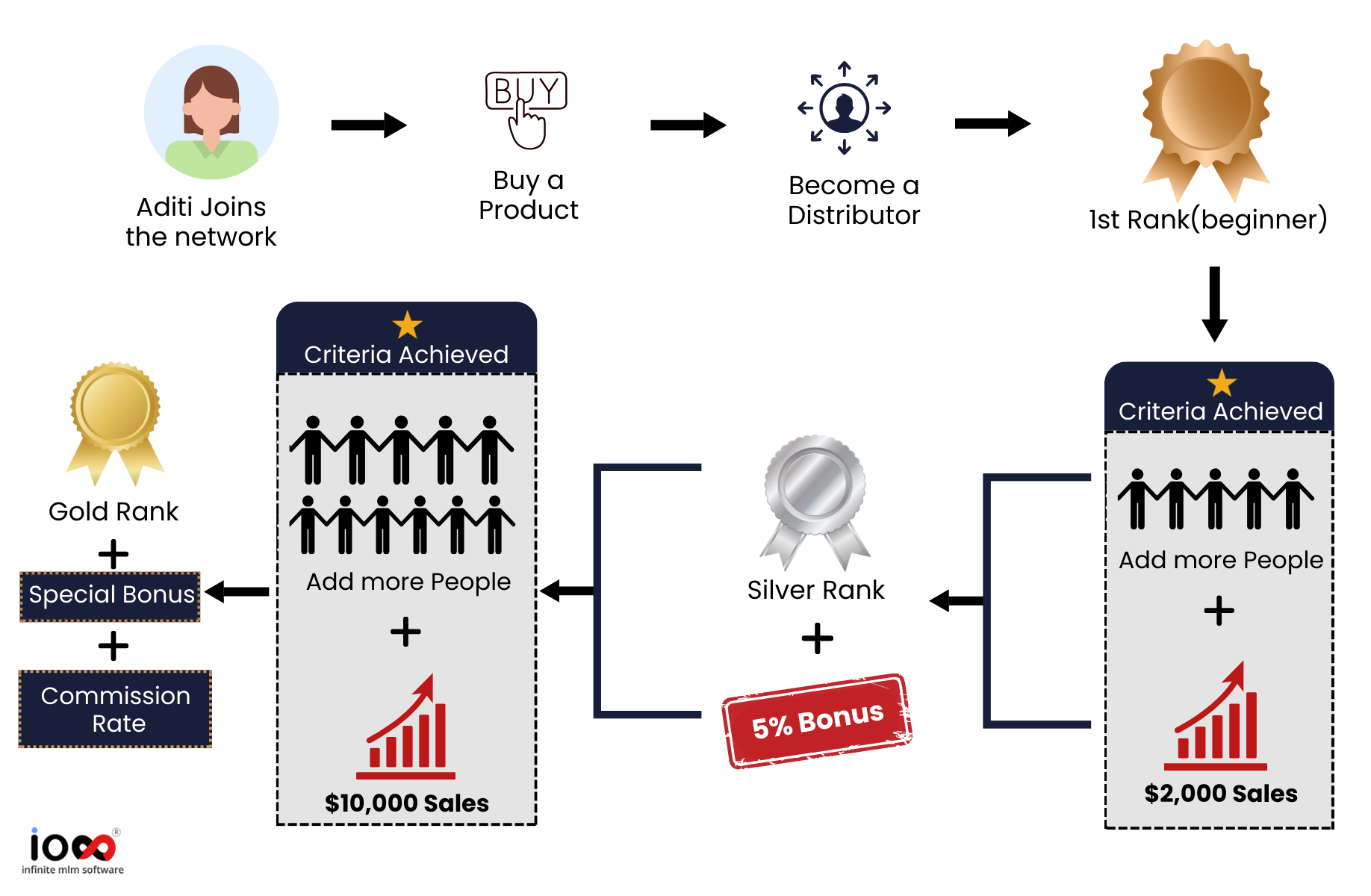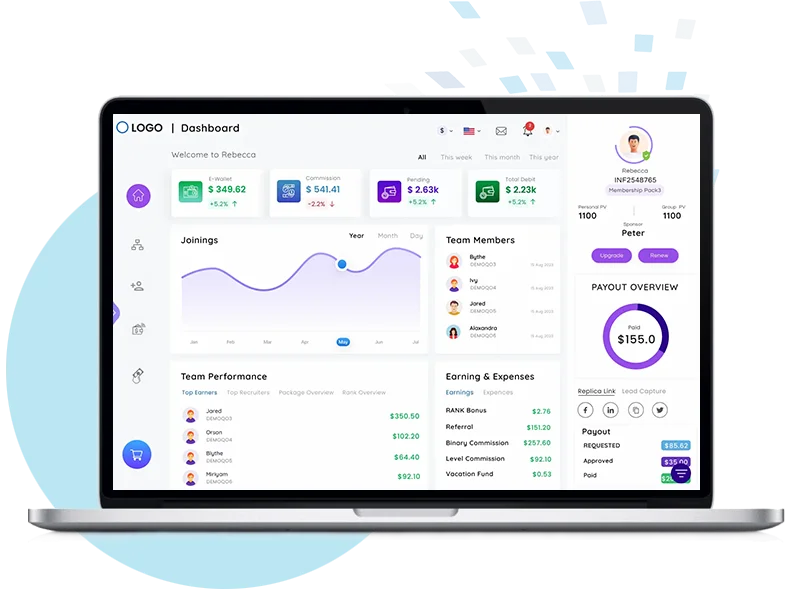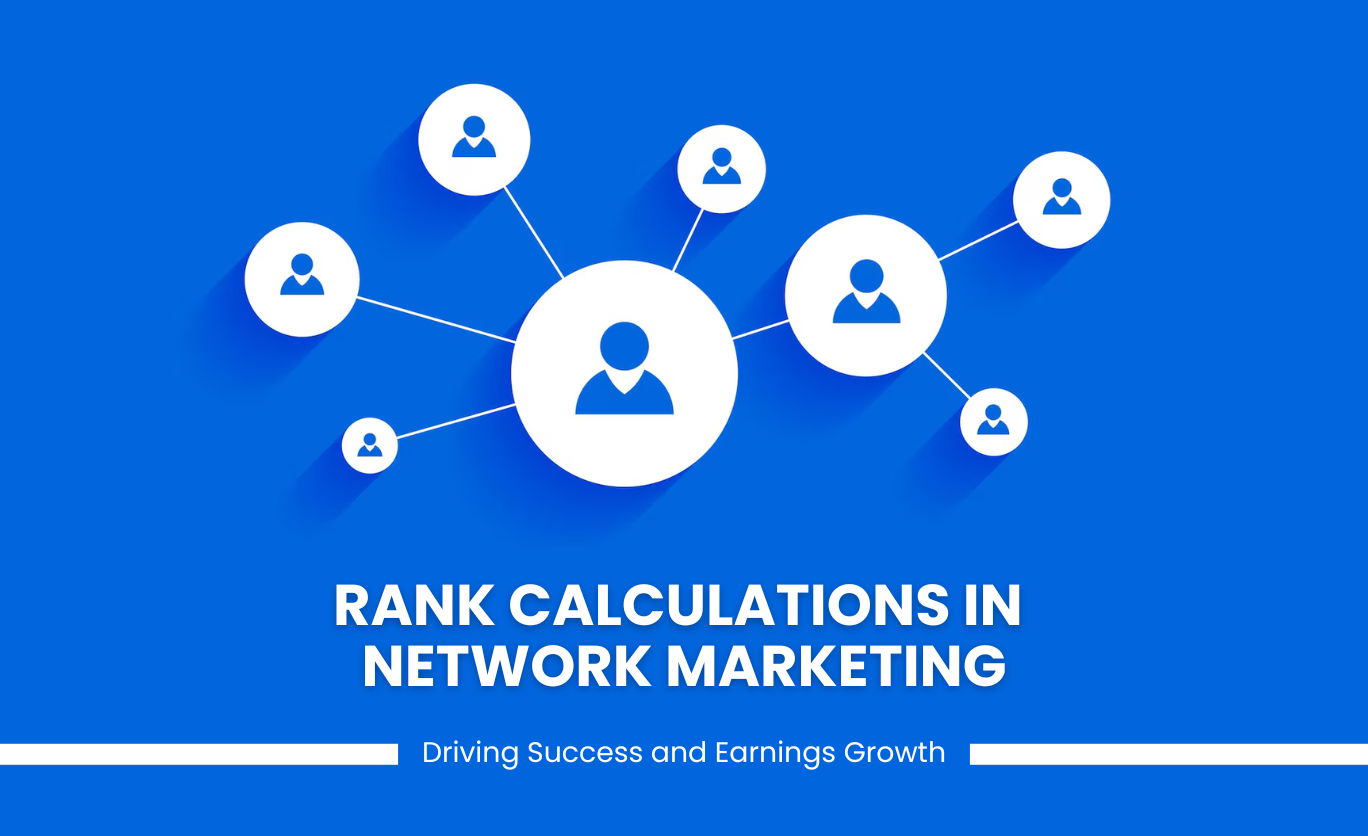Curious about what sets top network marketers apart from the rest? If you’re new to the game or have some experience, grasping the concept of rank calculations in network Marketing could be the turning point in your journey to success.
In multi level marketing, your rank is a reflection of your hard work and accomplishments. In simple words, rank in network marketing represents the level of achievement a distributor has reached within a company’s structure.It not only influences your earnings but also determines the opportunities and responsibilities that come your way. Understanding how rank calculations work is essential, as they evaluate your contributions in terms of sales and team growth.
Ready to uncover the ins and outs of rank calculations and how they can supercharge your success? This guide will take you step by step through the significance of ranks, how they are calculated, and strategies to help you rise through the ranks in network marketing. Let’s leap in!
What is Rank Calculation In Network Marketing?
In network marketing, rank calculation is the process used to determine a distributor’s position within the company hierarchy. These ranks are vital as they influence the rewards, commission management, and leadership roles a distributor can access. Essentially, rank calculation involves defining measurable criteria that distributors must meet to progress to higher levels within the organization.
In other words, Rank calculation in network marketing is essentially a system to measure a distributor’s success within a company. It determines their position in the company’s grading, which directly impacts their earnings and benefits.
The Key Terms Associated with Rank Calculation in Network Marketing:
Rank: A distributor’s position within the company’s hierarchy.
Commission: Earnings based on sales volume and rank.
Compensation Plan: The rules and guidelines for how distributors earn money, including rank calculations.
How it works:
Criteria: Companies set specific goals or requirements, like sales volume, team growth, or leadership skills.
Ranking: Distributors earn higher ranks by achieving these goals.
Rewards: Higher ranks often come with greater benefits, like higher commissions, bonuses, or leadership opportunities.
Rank calculations in network marketing typically factor in aspects like personal and group sales volume, team growth, and leadership skills. Distributors who meet or exceed these criteria can advance in rank, leading to increased earnings and influence within the company. Understanding how these calculations work is crucial for anyone aiming to succeed in network marketing.
The Power of Rank Calculations in Network Marketing and Its Importance
In the network marketing sphere, rank calculations are more than just a metric; they are a driving force that fuels the success of both individual distributors and the company as a whole. These calculations play a pivotal role in motivating distributors to strive for excellence, fostering a sense of community, and ultimately, propelling business growth.

Incentivized High Performance:
One of the most significant benefits of rank calculations is their ability to incentivize distributors to reach new heights. By clearly outlining the rewards associated with higher ranks, such as increased recognition, bonuses and commissions, companies create a compelling reason for distributors to push their limits. This competitive spirit not only drives individual performance but also contributes to the overall success of the network marketing organization.

Improvised Distributor Engagement:
A well-structured rank calculation system can significantly enhance distributor engagement and loyalty. When individuals understand the clear path to advancement and the rewards that await them, they are more likely to remain committed and motivated. This fosters a sense of community and belonging within the network marketing organization, leading to increased collaboration, knowledge sharing, and overall productivity.
Increased Earnings and Growth:
The impact of rank calculations on earnings cannot be overstated. As distributors climb the ranks, their earning potential grows, providing them with the financial incentives needed to continue building their business. This increased earning potential not only benefits the individual distributor but also contributes to the overall growth and success of the network marketing company.
In conclusion, rank calculations are a cornerstone of network marketing success. By incentivizing performance, fostering engagement, and boosting earnings, they play a crucial role in driving both individual and organizational growth. Learning how these calculations work is essential for anyone looking to thrive in the dynamic world of network marketing.
Different Types of Compensation Plans and Their Impact on Rank
Network marketing companies use various compensation plans to determine how distributors earn commissions and advance through ranks. Each plan has its own structure and impact on rank progression, so it’s important for distributors to understand the details of their company’s plan to maximize their earnings and advancement. Here’s a closer look at the three most common compensation plans; Binary, Unilevel & Matrix:

Binary Compensation Plan
In a Binary Compensation Plan, each distributor is assigned two legs—typically referred to as the left and right legs. The core idea is that distributors need to balance these legs to achieve rank advancement. The plan often requires distributors to generate a specific volume of sales or recruit a certain number of people in both legs to qualify for higher ranks.
Impact on Rank Calculation:
Balanced Growth: Success in this plan depends on maintaining balance between the two legs. If one leg outperforms the other significantly, it can create challenges in achieving rank advancements.
Incentive Structure: Distributors are incentivized to help their downline succeed to balance the legs and maximize overall sales volume, which can lead to higher earnings.
Challenges: The plan can be difficult for those who struggle with balancing legs or who have one leg that consistently underperforms.

Unilevel Compensation Plan
The Unilevel Compensation Plan is more straightforward. Distributors can sponsor an unlimited number of recruits, all of whom are placed directly under them in a single level. This plan rewards distributors based on the performance of their direct recruits, rather than on a structured hierarchy.
Impact on Rank Calculation:
Direct Sponsorship: Rank advancement often depends on the sales volume generated by the distributor’s direct recruits. This makes it crucial for distributors to build a large and productive team.
Mentoring: Success in this plan requires strong mentoring skills, as the performance of recruits directly impacts the distributor’s rank and earnings.
Potential for Growth: Distributors who excel in recruiting and training can benefit from significant earning potential, as rank is determined by the combined performance of their direct recruits.

Matrix Compensation Plan
The Matrix Compensation Plan limits the number of recruits a distributor can place on their first level to a specific matrix size. There are different types of Matrix MLM Plans that have matric types like; 3×3, 5×7, 3 x 2, etc.Each level in the matrix must be filled before the distributor can advance to the next rank.
Impact on Rank Calculation:
Structured Growth: Rank advancement is based on the distributor’s ability to fill their matrix and the performance of their team within it. This creates a structured path for growth.
Volume Requirements: To advance in rank, distributors must achieve specific sales volumes or recruit numbers at each matrix level.
Team Performance: The success of the distributor’s team affects rank progression, making it essential to develop a strong and effective team to fill the matrix and achieve higher ranks.
Each compensation plan has distinct characteristics that influence how distributors can achieve and advance through ranks. Differentiating the nuances of the specific plan used by their company allows distributors to tailor their strategies, optimize their performance, and maximize their earning potential.
Required Criteria for Rank Calculations in Network Marketing
We’ve already learned that rank calculations in network marketing are based on specific criteria that distributors must meet, and while these can vary depending on the company and its compensation plan, several core elements are commonly involved. Understanding these factors is key for those aiming to progress in their network marketing careers.

Sales Volume
Sales volume is a critical component for rank advancement, and it generally includes two types: personal sales and group sales. Personal sales refer to the total sales made by the distributor themselves using sales tactics, while group sales represent the combined sales of the distributor and their downline, the team members they’ve recruited. Companies typically set specific sales volume targets that must be achieved to advance to the next rank.

Team Growth
Team growth is another vital criterion for advancing ranks. This includes the number of new recruits a distributor brings into the network and the performance of those recruits. Companies may set requirements for the number of individuals a distributor must recruit or the sales targets their downline must achieve. Building an active and productive team is often necessary for rank progression.

Leadership Development
Leadership development is crucial in many network marketing companies for rank advancement. This involves assessing a distributor’s ability to mentor and nurture downline into effective leaders. Some companies require that recruits also advance in rank for their sponsor to progress, ensuring that leadership skills are cultivated throughout the network and reinforcing a strong organizational structure.
By focusing on these core criteria—sales volume, team growth, and leadership development—distributors can improve their chances of moving up the ranks, leading to increased rewards and recognition within their network marketing organization.
The Process of Rank Calculations in Network Marketing
Rank calculations in network marketing are a structured and multi-faceted process that evaluates distributors based on a range of performance metrics, including sales volume, team growth, and leadership development. For those seeking to advance in their network marketing career, a clear understanding of this process is essential. Here’s an in-depth look at how rank calculations typically unfold:

Establishing Initial Ranks
When a distributor first joins a network marketing company, they start at an initial rank. This starting position is usually assigned based on minimal entry criteria, which might include purchasing a starter kit or achieving a basic sales target. The initial rank acts as the foundational level from which distributors begin their journey toward higher ranks.

Regular Rank Evaluations
Rank evaluations are a crucial part of the rank advancement process and occur at regular intervals. The frequency of these evaluations depends on the company’s policies and can be daily, weekly, monthly, or at specific intervals such as quarterly. Here’s how these evaluations typically work:
Instant Rank Advancements: Some companies offer the possibility of instant rank advancements. When distributors meet or exceed specific criteria, such as hitting a sales target or recruiting a required number of new team members, their rank may be upgraded immediately. This approach rewards quick achievements and encourages prompt action.
Daily, Weekly, and Monthly Evaluations: These more frequent evaluations involve a systematic review of a distributor’s performance over short periods. The company calculates total sales volume, team growth, and other relevant metrics at regular intervals. This helps in determining if the distributor qualifies for rank progression. Daily evaluations are less common but may be used in fast-paced environments, while weekly and monthly assessments are more typical.
Periodic Evaluations: These evaluations take place less frequently, such as every three or six months. Periodic evaluations provide a comprehensive overview of a distributor’s long-term performance and growth. They often lead to significant rank advancements for those who consistently meet or surpass the company’s expectations over extended periods.

Manual vs. Automated Calculations
Traditionally, rank calculations were performed manually, requiring extensive time and effort. However, with technological advancements, most companies now use automated systems to simplify this process. Here’s a comparison of manual and automated calculations:
-
Manual Calculations:
Manual calculations involve manually tracking and computing sales, team growth, and other performance metrics. While still possible, this method is labor-intensive and prone to errors, which can lead to inaccuracies in rank assessments and delays in processing.
-
Automated Calculations:
Automated systems have revolutionized rank calculations by providing real-time tracking of sales, team performance, and other key metrics. These systems ensure greater accuracy and efficiency, significantly reducing the time and potential for errors associated with manual methods. Automated tools are now the standard for most network marketing companies due to their reliability and speed.

Strategic Implications for Distributors
Understanding the rank calculation process enables distributors to strategize their activities effectively. By focusing on achieving high sales volumes, fostering team growth, and developing strong leadership skills, distributors can align their efforts with the criteria for rank advancements. This strategic approach ensures that they meet the necessary requirements to progress within their organization and maximize their potential rewards.
In summary, the process of rank calculations in network marketing is a comprehensive system that evaluates distributors based on various performance factors. By understanding the nuances of initial rank assignments, regular evaluations, and the differences between manual and automated calculations, distributors can better navigate their path to advancement and achieve greater success in network marketing careers.
How Rank Calculations increase Business Growth: The Method for Scaling Success in Network Marketing
We’ve closely examined three compensation plans & criterias, and it’s time to learn the Rank Calculation Method. Let’s take the example of Unilevel MLM Plan:
In a Unilevel MLM plan, the rank system is structured to incentivize and reward distributors as they expand their network and hit specific sales milestones. Here’s how it typically works:
-
In this plan, each distributor recruits others directly onto their single level. This creates a straightforward hierarchy where each distributor’s direct recruits form their downline.
-
Distributors progress through various ranks; such as Beginner, Silver, Gold, etc. by meeting certain criteria. These criteria often include sales volume, the number of recruits, or a combination of both.
-
Advancing in rank usually brings enhanced rewards, such as higher commission percentages, additional bonuses, or exclusive incentives. Each rank has its own set of benefits, reflecting the distributor’s performance and contribution.
-
The rank system encourages distributors to continually expand their network and increase sales. As they build their team and achieve higher sales, they climb the ranks, which motivates ongoing effort and performance.
-
#Example:
Aditi joins a Unilevel MLM company that sells skincare products. She starts at the “Beginner” rank.
To
advance to the next rank, “Silver,” she must achieve certain criteria set by the Network.
Let’s
learn in
detail;
-
Initial Rank – Beginner: Aditi will become a “Beginner” in the network and thereby achieves the 1st rank by Purchasing a product. Her goal is to recruit five people – her Level 1 recruits and assist them in generating $2,000 in total sales.
-
Silver Rank: After successfully recruiting five individuals and helping them reach $2,000 in sales, Aditi qualifies for the “Silver” rank. At this level, she earns a 5% bonus on the sales made by her recruits.
-
Gold Rank: As Aditi’s team grows and achieves a total sales volume of $10,000, she progresses to the “Gold” rank. This higher rank comes with increased commission rates and additional special bonuses.
In this rank system, Aditi’s progress is based on her team’s growth and sales performance. She is rewarded for both expanding her downline and supporting her recruits to achieve sales targets.
Overall, the rank system in Unilevel MLM plans is a key component that drives network growth and distributor motivation through clearly defined goals and rewards.
While the Unilevel plan is designed around a single-level hierarchy, the rank system concept is
adaptable. It can also function effectively in other MLM structures, such as Binary or Matrix
plans, by
adjusting the rank criteria and rewards to fit the specific model.

Advanced Tools for Rank Calculations in Network Marketing
In the competitive landscape of network marketing, the accuracy and efficiency of rank calculations can significantly impact distributor motivation and satisfaction. Advanced tools designed for this purpose not only simplify the complex calculations involved but also ensure that rewards are distributed fairly and transparently. By leveraging these innovative solutions, businesses can enhance operational efficiency, reduce errors, and foster a more motivated sales force. Here’s a closer look at some of the advanced tools available for rank calculations in the MLM industry;
Rank Calculators
Rank calculators are specialized tools that assist distributors and companies in determining ranks based on various criteria. There are several MLM Calculators available in the market that often integrate with these rank calculators, providing a comprehensive solution for managing commissions and bonuses in network marketing. These calculators consider factors like sales volume, team growth, and leadership development, offering a clear and accurate view of a distributor’s position within the rank hierarchy. They can be utilized manually or automatically, depending on the company’s preferences, and are especially beneficial for complex compensation plans where multiple elements affect rank advancement.
MLM Software Solutions
Beyond rank calculations, Multi-Level Marketing software solutions offer a comprehensive approach to managing network marketing operations, including rank calculations. These software features automate the entire process, from tracking sales and team performance to calculating commissions and ranks. It is an indispensable tool for businesses of all sizes. MLM software provides distributors with tools to easily monitor their progress, set goals, and strategize for higher ranks. It also enhances transparency and accuracy in rank calculations, minimizing the risk of disputes and errors.
By using advanced tools such as rank calculators and MLM software, distributors can stay competitive in the network marketing industry. These tools not only smooth rank calculations but also offer valuable insights for business growth. With the aid of technology, distributors can focus on building their business and advancing through the ranks, confident that their efforts are accurately tracked and rewarded. By using the opportunities of MLM software companies can expand business globally and ensure more sales volume there by conquering a huge profit.
Common Challenges in Rank Calculations and How to Overcome Them
Rank calculations in network marketing can present various challenges due to the complexity of compensation plans and performance metrics. Below are some of the most common challenges faced during rank calculations and strategies to overcome them.
Misinterpretation of Rank Criteria
Challenge:-
There are several misconceptions
about network marketing , and
misunderstanding or misinterpreting the specific criteria for rank advancements is a
frequent issue in that array. Distributors may not fully grasp the sales volume, team
growth, or leadership requirements necessary to advance, leading to confusion and missed
opportunities.
Solution:-
Clear communication and knowledge in MLM helps to address this
challenge. Inorder to flourish more companies can provide multi-level
marketing Training.
Along with that, companies should provide detailed explanations of rank criteria through
training materials, webinars, or FAQs. Additionally, offering distributors access to
user-friendly rank calculators or dashboards that display their current standing can help
them track their progress and ensure they understand the requirements for each rank
advancement.
Managing Complex Compensation Plans
Challenge:-
Many network marketing companies use intricate compensation plans
with multiple layers and performance factors. Managing these complexities can make it
difficult for both companies and distributors to track rank progress, particularly when
multiple variables, such as team performance, leadership development, and bonus structures,
are involved.
Solution:-
The best way to manage complex compensation plans is by
implementing Best MLM
software solutions. These software systems are designed to automate
the process of tracking sales, team growth, and other rank-related factors. By using
advanced algorithms, the software simplifies complex compensation plans and ensures accurate
and efficient rank calculations, providing real-time updates and clear visualizations of
rank progress.
Ensuring Accuracy in Rank Calculations
Challenge:-
Errors in rank calculations can lead to incorrect rewards,
disputes, and dissatisfaction among distributors. Manual calculations, especially for large
organizations, are prone to inaccuracies and may result in delays or inconsistencies in rank
advancements.
Solution:-
Automating rank calculations with reliable MLM software is the
most effective way to ensure accuracy. These tools reduce the risk of human error by
automatically calculating ranks based on real-time data inputs. MLM software
integration
helps manage and automate various aspects of an MLM business, including tracking sales,
commissions, rank calculations, downline relationships, and other essential
operations.Regular audits of the system, coupled with transparent reporting, can further
guarantee accuracy and maintain trust among distributors. Additionally, companies should
provide clear guidelines for resolving any rank calculation discrepancies swiftly and
fairly.
By addressing these challenges through clear communication, advanced software, and automation, companies can ensure smoother rank calculations and provide distributors with a more transparent, efficient path to advancement.
Conclusion
In network marketing, understanding and managing rank calculations is key to individual success and business growth. Ranks reflect a distributor’s efforts and leadership, and meeting criteria like sales volume, team growth, and leadership development unlocks new MLM earning opportunities.
While rank calculations can be complex, using advanced tools such as rank calculators and MLM software simplifies the process, ensuring accuracy and transparency. There are many advantages of integrating network marketing to MLM software. For example, MLM software offers advanced rank calculation and commission management, including a unique “rank vesting” feature for instant advancements. Similarly, it provides calculators for different MLM plans, helping to verify profitability and success rates. In short, choosing the right MLM system is crucial because the provided MLM Features can uprise your business into a whole another level. So, choose wisely! It can change your story.
Frequently Asked Questions
Rank represents a distributor’s level of achievement and determines their earnings and leadership opportunities within the company.
Yes, many companies use MLM software to automate rank calculations, ensuring accuracy and reducing errors.
The main criteria typically include sales volume, team growth, and leadership development.
Different compensation plans, such as Binary, Unilevel, and Matrix, have unique structures that influence how ranks are calculated and advanced.
Rank calculations can be performed instantly, daily, weekly, monthly, or periodically, depending on the company’s policies.
A level commission rewards distributors with a percentage of earnings from the sales generated by each level of recruits in their downline. The individuals from whom a distributor receives commissions make up the distributor’s payline. In the simplest structure, each level provides the same commission percentage across all levels.
- Board Plan MLM Software: Everything Growing Networks Must Get Right
- Why Global MLM E-Commerce Fails Without an Integrated Commission Management Platform
- The Global Payout Solution: Why Direct Selling Organizations Must Pay Distributors Instantly in 2026
- Questions Every Growing MLM Business Should Ask Before Choosing Software
- The Global Payout Problem: Handling Multi-Currency Commissions in Real-Time
- 90-Day Plan for Your Multilevel Marketing (MLM) Business:
- Service-Based MLM Software: How to Choose the Right Platform
- Automating Distributor Education: Why You Need an Integrated LMS










